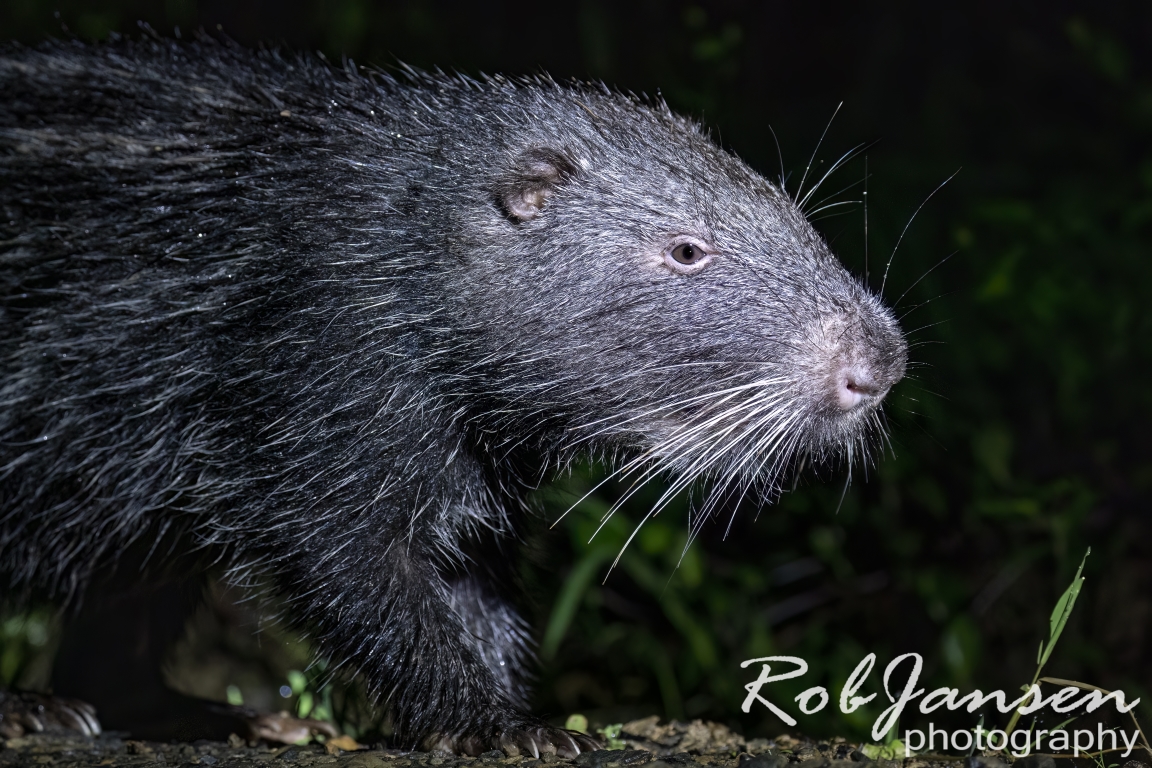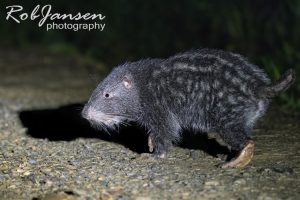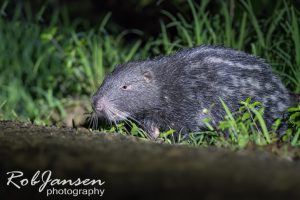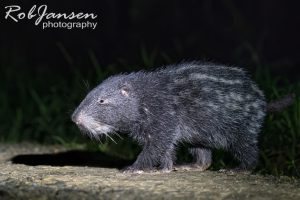
It’s a Wild Life! – Pacarana Encounter
Of course there will be a Trip Report from our full Ecuador trip soon, but multiple members of this community encouraged me to make a separate post about this elusive mammal. Some of you will be familiar with the Mashpi Amagusa Reserve near Mindo, Ecuador. Western Mountain Coati is sometimes very confiding at the feeders, and there are quite some good birds to see around too. We had already spent a couple of days at the reserve, seeing Red-tailed Squirrel and Western Dwarf Squirrel during the day. Spotlighting at night along the main road yielded Olinguito during 2 nights mammal-wise. We hoped for Andean Porcupine, which the owners had observed once before and should occur at this altitude. We left without Western Mountain Coati, but we liked the place so much that we recommended it to another birder and overlander (someone travelling with a motorhome like us).

A couple of days later. Just when we wanted to drive south from Santo Domingo we got a message from that birder we had recommended Mashpi to. The message included a picture and the question: “Observed this morning. Can’t find what it is, do you know?” I opened the picture and made some shouting sounds. Romy thought something bad happend. Even though the photo was blurry; that was clearly a Pacarana! For those who don’t know, this species is quite enigmatic and elusive and rarely seen in the wild. Calling right away to get some more info we turned the car around and 2 hours later we were back at Mashpi again. We got the update that they had walked towards an Antpitta in the morning on the main road and at 05.47 encountered the Pacarana casually sitting on the road. The flashlight didn’t bother it and it walked along the road and sat again, doing this a couple of times before it took off onto a steep slope around 05.51. As this mammal is nocturnal and the slope was quite steep we figured it would have a burrow of some sorts there and it might reappear there that evening. So just after 18.00 we set off and put food out (rice, plantain, papaya peels) to see if an animal like this could be lured to a feeder in the future by Sergio. We stationed ourselves in some chairs at 100m distance and scanned with the Lahoux Spotter Elite 35V thermal camera.
It started to rain quite hard, so we huddled under umbrellas, hoping the rain would stop. As the slope was exactly in a bend of the road, Romy set out walking the road around the corner, to be sure it wouldn’t come off the slope at another point. We agreed she would flash her green laser 2 times if she would see anything. After she made that round a couple of times I saw 2 flashes and ran over there. Despite the rain some mammals were still out there, good! Something in the tree, of course not the individual we were looking for, but we got nice views of Central American Woolly Opossum. I was able to get good shots and went back to our chairs. After 2 hours the rain had stopped and now it just dripped from the trees still. After more than 3 hours Romy walked the road again for the umpteenth time. I was selecting the Opossum pictures from the viewer of the camera and was therefore night-blinded. Then suddenly laser flashes, not two, but a continuous stream. Flash-flash-flash-flash. Half-blinded I got up and started to run. Flash-flash-flash-flash-flash. Green lasers shooting above the bend in the road. Sh*t, my flashlight! I ran back to get by flashlight, grabbed frantically around in the dark to find it as I was still night-blinded. Flashflashflash!
During what seemed to be an eternity I grabbed the flashlight, while behind me laser flashes kept going off. Flash! Flash! Flash! I turned on my flashlight and ran as fast as I could, faster and faster. FlashFlashFlash! Already out of breath, finally seeing Romy because of my spotlight I ask her “Where?! Where?!”. Romy: “You’re standing right next to it!”. I looked to my right and there it was, a real Pacarana, within less than a meter from me!!! It apparently had come to the road within the 2 minutes Romy had passed the spot and turned around. It had come to the other side of the road, and was walking towards me sitting in the chair (or the food), but me storming towards that spot had made it go back to the slope.
The Pacarana, a large male with a darkish head, went to the gully next to the road again. It was only that we knew it was there that we were still able to observe some small eye-shine and heat in the thermal camera, otherwise we would have walked straight past it. We waited for a while and it came back on the road, allowing for some nice pictures. It actually walked straight towards me lying on the ground and it wasn’t bothered at all when I walked towards it to pick an photographically ugly leaf from its back. It went from side to side on the road searching for something, not really making clear movements. But this allowed for great views of this awesome looking, slow-moving and weirdly walking rodent (the biggest in South-America after the Capybaras). After a while it moved down the very steep slope, in a small gully that seems to be used more often by wildlife.
Excitingly we walked back and spotted Northern Black-eared Opossum at the lodge. We went to bed around 22.30 but couldn’t sleep until 01.00 because of the adrenaline. The alarm was set at 04.00 again and we waited at the same spot to see if it would cross the road again to go back to the presumed burrow. It didn’t. We walked the road again for 2.5 hours that following evening in dense fog, but didn’t encounter any mammal.

For the owner Sergio it was the first time he had ever seen this animal (that morning), but his mother who lives next door has seen one walking through the former pastures (they are reforesting that part now) about 8 years ago. It has also never been seen on camera traps, but it didn’t seem like they had many camera traps out there or that they specifically set them up at burrows that could be Pacarana’s. They also don’t go out a lot to search for mammals at all it seems, as they are more focused on birders. We can imagine them passing by one walking in the gully and missing it easily after our experience. The food we put out was basically untouched even after two days, so that didn’t seem to be attractive to the Pacarana after our encounter.
I was talking with Rob Smith from WildAboutColombia and he figured that young males roam in search for new territory and that’s when people see them. Supporting this theory is the encounter of a Pacarana on the exact same day, but then way farther south along the rail tracks to Machu Picchu in Peru by someone on iNaturalist. He said he was looking for moths and ran into a Pacarana as well. Like ours it wasn’t bothered by flashes or light and stumbled within inches of them before turning around. The lodge owners there (Mandor Machu Picchu) had never seen a Pacarana before either.
Chances of actually seeing one at Mashpi Amagusa are probably still very low, but it does motivate to know they are around here. Especially when there are also chances for other interesting species like Western Mountain Coati, Olinguito, 2 Squirrel species, at least 2 Opossum species, Andean Porcupine and who knows what else.
Visit the website to see more and on how to reserve: https://mashpi-amagusa-reserve.com/
All the best, Rob (& Romy) Jansen

Post author
4 Comments
-
JanEbr
I had no idea Pacaranas are so difficult to see. We were told by rangers that one lives right next to the ranger station in Yanachaga-Chemillen in Peru (Huampal sector) – we tried to wait for it for some time after dark with no success, but that was way back (2014) where we had no idea about mammalwatching. Then we saw one on a leash, following a kid as a pet 🙂
Leave a Reply
You must be logged in to post a comment.


Jon Hall
Wow wow. So cool. This is a species that is already on my 21 most wanted and now shot up to the top 5. Very jealous and thanks for sharing. Now we need to find a den!